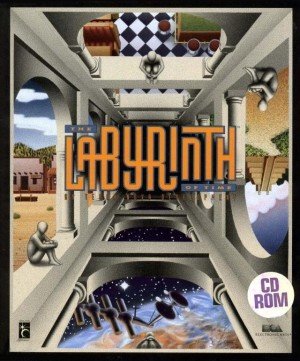Review for The Labyrinth of Time
Some developers reveal an almost poetic sensibility when choosing the titles of their games, which although lyrically pleasing could mislead potential buyers. To be sure, Grim Fandango was no dance platform game; nor was there overly much digging to be done in The Dig. Fortunately, no such confusion is created by the 2004 re-release of The Labyrinth of Time. As the title suggests, this game is about a labyrinth... of time. The rest is fairly self-explanatory.
The gamer is cast as a world-weary commuter, who spends much of the introductory sequence bemoaning the monotony of a humdrum existence. On boarding the subway, there is a sudden pulse of light, and Daedalus, the famed mythical craftsman, arrives to deliver a dire message. He has been enslaved by the megalomaniac King Minos and forced to build a labyrinth which will stretch across space and time. When completed, this will allow Minos to conquer the world in all ages. In order to stop him, the gamer must navigate a diverse series of interlocking mazes, travelling through several time periods and locations.
This version of Labyrinth of Time is an updated release of the 1993 Terra Nova Development classic, now made compatible with newer operating systems and available to buy from The Wyrmkeep Entertainment Co. Labyrinth is a first-person adventure with slideshow navigation and, in keeping with the time of release, no 360-degree panning. The graphics consist of three-dimensional environments, rendered in 8-bit colour. Viewed over a decade later, the graphics appear blocky, and even when compared to the game's contemporaries such as Myst, they lack the same visually arresting quality, as well as the fine attention to detail.
Labyrinth's greatest strength lies in the fundamental concept of the game—travelling through a number of different time periods. This allows the developers to embrace a range of visual styles and palettes, from the orange desert tones of a Wild West ghost town, to a stylised art deco theatre to a Mayan temple, to name a few. Daedalus' somewhat haphazard labyrinth construction allows for rapid transitions in style, which held my interest and often surprised me as I walked from a medieval maze into a '50s diner, or from a seedy hotel into an elaborate mirror maze. Unfortunately, in order to prevent you from getting your bearings, several of the mazes recycle similar or identical rooms over and over again. Although the mazes are initially interesting to explore, if only to see where you will end up next, you are forced to travel through each maze repeatedly in order to complete the game. Without the novelty of exploring new areas, the mazes soon become tedious, and I was left with little admiration for the mirror maze by my seventh (and certainly far from last) crossing.
At the bottom of the screen is a toolbar, which features directional arrows and picture icons representing verbs such as "open", "take" and "look". There are keyboard shortcuts for these icons, which speeds up gameplay considerably. There is also a map and an inventory display which overlays the main screen. The map screen itself is one of the outstanding features of the game, as it pinpoints your current position, the direction you are facing, and the areas of the labyrinth which you have explored so far. This makes Labyrinth of Time passable for even the most maze-phobic of adventurers, removing much of the frustration commonly caused by maze puzzles—namely, getting lost. There is an option to drop "virtual breadcrumbs", allowing you to automatically retrace your steps, but this is hardly necessary with the mapping system, and I only used it on rare occasions.
Due to its development in the early '90s, Labyrinth of Time's dialogue is entirely text-based, using no voiceover work for the characters. Although it would have been nice to have a score which reflects the transitions in time period, the soundtrack does consist of well-selected looped tracks, which adds to the eeriness of the labyrinth.
Unlike its puzzle-heavy contemporary, Myst, there are few real challenges in Labyrinth. In order to defeat the labyrinth, you need to make your way to the centre of the maze and find a way to destroy its keystone. This requires you to not only negotiate the mazes, but also to collect inventory items and flick a couple of levers on the way. The most interesting aspect of puzzle solving is that changing things in the past affects the future, causing history to be rewritten, and inventory objects to appear in different time zones. This is essential to the sub-plot involving an archaeologist's obsession with a Mayan artefact, which is recorded in his journal. When past events are altered, this journal is rewritten, providing valuable clues on how to proceed. Tasks also include locating one of a number of keys, a sliding-tile puzzle, and several inventory-based trials. Because there are no other characters to interact with, there is also a fair bit of reading to be done in the form of computer archives and the aforementioned journal, if you are to immerse yourself in, and fully understand, the game's plot.
With regard to the inventory-based puzzles, if long-term adventuring has taught me anything, it's the value of indiscriminate kleptomania. Picking up whatever isn't nailed down is always my first priority, and working out a way to prise free whatever is comes second. Initially, Labyrinth seemed to indulge me in this respect, allowing me to assemble a positive arsenal of knick-knacks in my journey through space and time. Frustratingly, however, only a small fraction of these objects could be put to any practical use despite tantalising suggestions to the contrary. I was particularly keen for the natty alien belt I found to do something spectacular, but I was to remain disappointed. Some of the puzzles retain a zany type of logic in their execution, but others have seemingly arbitrary solutions. Furthermore, some of the useful inventory items you require are hidden in completely illogical places. This will cause some variation in the length of gameplay—I played Labyrinth over the course of one rainy Saturday, but could have spent hours or even days longer wandering aimlessly through the maze, had I not randomly hit upon some of the puzzle solutions.
The Labyrinth of Time fails to satisfy, but not for the expected reasons. The game doesn't fail because the mazes that form such an integral part of gameplay are frustrating—indeed, the mapping function makes the game's labyrinthine world suitable for maze-philes and maze-phobics alike. Instead, despite an interesting plot and engaging shifts in visual style, Labyrinth is doomed to blandness through constant repetition and recycling. Once-captivating environments soon lose their charm after being traversed for the nth time, and there is little payoff at the game's completion, aside from a cursory pat on the head from Daedalus, and the knowledge that you will never, ever have to walk through that accursed mirror maze again!


























